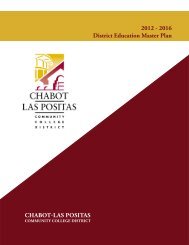City College of San Francisco - California Competes
City College of San Francisco - California Competes
City College of San Francisco - California Competes
Create successful ePaper yourself
Turn your PDF publications into a flip-book with our unique Google optimized e-Paper software.
THEME II<br />
Over half <strong>of</strong> the colleges reported that one <strong>of</strong> the first steps they took was the development <strong>of</strong> some type<br />
<strong>of</strong> common examination administered to students enrolled in a specific sequential basic skills class. To<br />
develop these assessment tools, the faculty focused on the core skills and competencies that students<br />
needed to succeed in the subsequent course. In effect, the faculty dealt with learning outcomes for two<br />
classes to assess the effectiveness <strong>of</strong> instruction in one class. While no single assessment instrument can<br />
be expected to fully measure the learning outcomes for an entire course (let alone predict with complete<br />
accuracy student success in a subsequent course), the act <strong>of</strong> developing these assessment tools produced<br />
much clearer delineations <strong>of</strong> the intended outcomes for courses, insights into how to assess those<br />
outcomes, and, most important, how to improve those outcomes through course modifications and<br />
improvement in instruction. These were not efforts to “teach to the test.” They focused on the faculty’s<br />
use <strong>of</strong> the results <strong>of</strong> the assessment to improve their students’ learning. As Carnegie Foundation resident<br />
senior scholar Lloyd Bond, a highly respected expert in assessment, summarized this phenomenon,<br />
“You start with the test, and work backwards to what goes on in the classroom.” The experience that<br />
the CCSF English Department had with the implementation <strong>of</strong> its common exam for English 94 is an<br />
excellent example <strong>of</strong> this process and its potential consequences. 6 While the English Department started<br />
with a single purpose—assessing a limited set <strong>of</strong> outcomes in a crucial course in the reading and composition<br />
sequence—the results <strong>of</strong> that assessment led to a thorough revision <strong>of</strong> the course and a reassessment<br />
<strong>of</strong> the other courses in the sequence.<br />
Many community college English departments use holistically graded essays or portfolio reviews as a<br />
significant exit measure for a course. While state regulations specify that <strong>California</strong> community colleges<br />
cannot have “exit tests” for courses, these exams or portfolios frequently are so heavily weighted in calculating<br />
the term grade that the exam or portfolio has been, de facto, a kind <strong>of</strong> exit test. These holistically<br />
graded exams or portfolios are supposed to reflect the validity <strong>of</strong> a course’s objectives. The variations in<br />
student success on these exams are generally attributed to the expected variations in student achievement,<br />
differences in instructional quality, or, in some cases, the variability or the quality <strong>of</strong> the exam or portfolio<br />
evaluation process. Rarely does the assessment seem to reflect back on the validity <strong>of</strong> the essential<br />
objectives <strong>of</strong> the course itself. The CCSF English Department, through a combination <strong>of</strong> serendipity<br />
and strategy, found that when such assessment tools are chronologically distanced from the end <strong>of</strong> term<br />
and their impact on individual student’s success or failure is minimized, they can much more effectively<br />
direct faculty attention to the integrity <strong>of</strong> a course outline and their own classroom practices.<br />
The context. English 94 is an integrated developmental reading and writing course in the middle <strong>of</strong> a<br />
five-course composition sequence ending with English 1A. English 94 is two levels below 1A. Given the<br />
size and diversity <strong>of</strong> the <strong>College</strong>’s student population, English 94 accounts for approximately 20 percent<br />
<strong>of</strong> the composition <strong>of</strong>ferings, with between 37 and 44 sections scheduled every semester. Historically,<br />
English 94 has been the “problem class” in the <strong>College</strong> English composition sequence. Because students<br />
enter English 94 through one <strong>of</strong> three pathways—English 92, the previous course in the sequence; ESL 82,<br />
the final course in the ESL sequence; and directly from testing and placement—the course presents faculty<br />
with a challenging heterogeneous student population with highly varied linguistic, writing, and thinking<br />
skills compounded by deficiencies in college success skills. In addition, over the years, the English<br />
sequence has undergone many transformations that range from abolishing an old de facto tracking<br />
system, designed to distinguish between transfer and vocationally oriented students, to efforts to maximize<br />
students’ ability to use a broad range <strong>of</strong> sequential courses to meet transfer institutions’ general<br />
education written communication requirements. As a result, some <strong>of</strong> these sequential course outlines<br />
have what one faculty member typifies as an “everything but the kitchen sink approach” to defining the<br />
expected outcomes. This, in turn, provides for extremely divergent interpretations <strong>of</strong> the course’s priorities<br />
by the many faculty teaching the very large number <strong>of</strong> sections.<br />
6 This description <strong>of</strong> the English 94 initiative at CCSF is partially adapted from a Listserv essay titled “Course-Based Assessment<br />
as a Catalyst for Curricular Change.” Learning Assessment Listserv. Published 19 May 2004. Accessible at<br />
<br />
266 CITY COLLEGE OF SAN FRANCISCO







